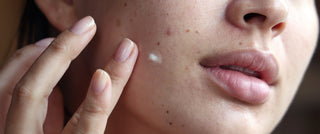If you’re past the point of dark spot prevention (welcome to the majority) and staring down a few pesky marks that just won’t fade, you might be wondering: Is it too late to fix this?
Our expert answer: Absolutely not.
Dark spots, albeit stubborn, can be managed with the right approach. The key is consistency, realistic expectations and a combination of both proactive and corrective care. Whether you’re just starting to notice hyperpigmentation or have been trying to fade your spots for a while, here’s how to approach treatment in a way that actually works.
Adjust your daily routine
Dark spots form when areas of your skin produce excess melanin, the pigment responsible for your skin tone, in response to triggers like sun exposure, inflammation or hormones. To fade your spots, you’ll need a combination of dark spot-targeting ingredients, gentle exfoliants to encourage skin turnover and barrier-boosting hydration. Translation: your daily routine needs an upgrade.
This doesn’t necessarily mean starting from scratch, but it does mean getting intentional about what you put on your skin. Start by swapping in targeted formulations that prevent excess melanin from forming while gradually fading existing spots. Look for ingredients that target spots and strengthen your skin’s barrier simultaneously.
Ingredients like vitamin C and tranexamic acid are superstars when it comes to targeting stubborn dark spots. Together, these two help protect, brighten, firm and support your skin’s healing journey.
Remember: Real results happen with consistency and proper product layering so each formula can do its job most effectively.
Be proactive
Even if you’re already dealing with unwanted dark spots, that doesn’t mean the rest of your skin is a lost cause. Protecting your skin now helps stop future discoloration from forming, because, unfortunately, every breakout, sunburn or inflammation flare-up is an opportunity for new spots to develop.
Here are some expert skin defense tips:
Prioritize daily sunscreen, no matter the weather or your skin tone
UV rays are one of the biggest (and sneaky) culprits behind dark spots. They can penetrate clouds, glass and even some clothing. Wearing a broad-spectrum SPF 30 or higher every single day (yes, even if it’s cloudy) is your best defense.
Target inflammation before it becomes pigmentation
Dark spots can begin with irritation, especially if you have acne-prone or sensitive skin. The more inflamed the skin, the more melanin it’s likely to produce as a response. That’s why calming, barrier-supportive ingredients, like niacinamide, are key. Think of it as treating tomorrow’s dark spots before they even start.
Be gentle with your skin
Harsh scrubs, picking at breakouts and over-exfoliating can all trigger inflammation, making hyperpigmentation worse. Instead, focus on healthy skin barrier-building habits and resist the urge to pick or pop.
Level up with professional treatments
If you’re looking for faster, more targeted results, professional treatments like these can accelerate progress:
-
Chemical peels
Chemical peels use acids (like lactic and glycolic) to exfoliate the upper layers of the skin and stimulate cellular turnover. By encouraging new skin to surface, they help diminish the appearance of dark spots and smooth out uneven tone.
-
Clinical skin brightening treatments
Clinical skin brightening treatments can help target dark spots, dullness, discoloration and uneven tone. In addition to the exfoliation you receive from a typical chemical peel, these treatments take it one step further with added brightening benefits to truly target stubborn spots.






































